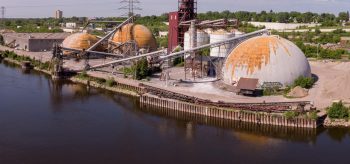 By Grace Corbin
By Grace Corbin
About a week and a half ago, an ecumenical group of 30 people ventured on a “toxic sites bus tour” of North Minneapolis. This bus tour, led by northside residents, brings people to some of most toxic sites for the water, air, land, and people in the State of Minnesota. The tour included Northern Metals Recycling, GAF, the site for the Upper Harbor Terminal project, and others.
Northern Metals, a metals recycling company right on the banks of the Mississippi River, was accused by the Minnesota Pollution Control Agency of contributing to poor air quality in 2017. Because of years of outcry from North Minneapolis residents, Northern Metals has finally agreed to move outside of the Minneapolis area by August 2019.
When we drove into GAF, a shingles roofing company construction site, I could immediately smell a difference in the air. It felt a thickness in my lungs when breathing in and, even though we were only there for 5 or 10 minutes, I left with a headache.
ROSTERED AND LAY leaders share in the responsibility of care for God’s creation. Often we assume that concern involves hikes in the woods and visits to the beach. But cities, too, are part of God’s creation. And, urban centers regularly are the recipients of environmental racism — the most toxic aspects of our society are dumped on those most considered expendable by the powerful. (This bias was also true in the days of the prophets, and they reacted strongly.)
“Often we assume that concern about God’s creation involves hikes in the woods and visits to the beach. But cities, too, are part of God’s creation.”

Upper Harbor Terminal
The recent toxic sites tour was intended to give people of faith an opportunity to learn about a new development coming to North Minneapolis — the Upper Harbor Terminal. This site, originally used as a barge shipping terminal, closed in 2014 and is now in the hands of Minneapolis elected leaders. The city has long been discussing what to do with piece of land. Leaders almost came to an agreement that would bring an outdoor performance venue, new units of housing, retail, and maybe a hotel to the 48-acre space.
Development has the potential to benefit a community. Unfortunately when mocking up the development of the Upper Harbor Terminal, input of those most affected by the new development — northside residents — was not sought. New development, when it comes to an area that is already disenfranchised, poses the threat of gentrification, the planned displacement of residents who have long lived in the area.
The impact of gentrification was seemingly not considered when looking at the new development. Northside residents have been pushing back against this development due to the lack of community involvement which has caused the city to take a step back and receive more community input mainly through a new advisory committee.
People of faith who care about environmental, racial, and economic justice ask, “What is our role in walking alongside northside residents in this development process? How do we live out our values of justice?”
“When mocking up the development of the Upper Harbor Terminal, input of those most affected by the new development — northside residents — was not sought.”
These and similar questions will be discussed at a conversation about what positive input people of faith can have in the Upper Harbor Terminal development project on August 18. Come join us for an important conversation about the Upper Harbor Terminal and our stake in its just development.

